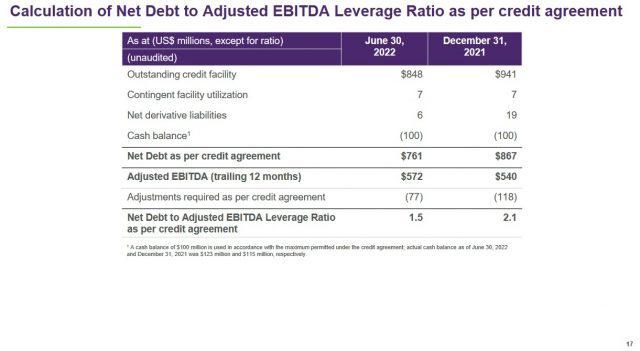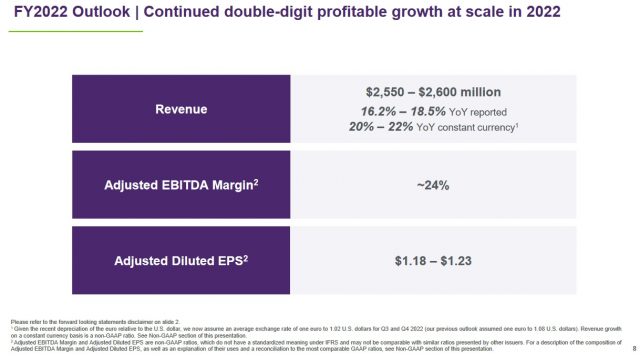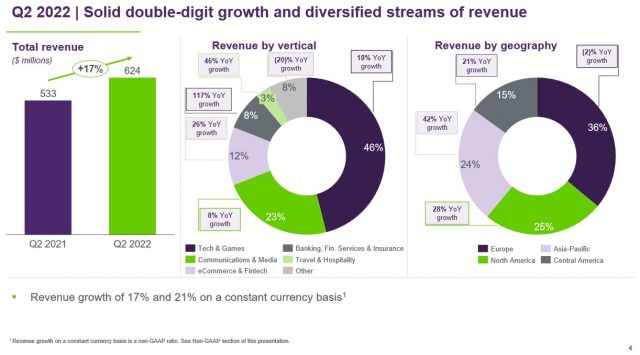Contents

I first reviewed TELUS International (Cda) Inc. (TIXT) in my February 16, 2021 post at which time I disclosed a new 400-share position @ ~$39.48 in one of the ‘Core’ accounts in the FFJ Portfolio.
Following the release of Q2 and YTD2021 results, I revisited TIXT in my August 1, 2021 post.
Now that TIXT has released Q2 and YTD2022 results and FY2022 guidance, I have exited my position on August 15, 2022 @ ~$40.3525. My primary reasons for this are:
- my desire to increase the concentration of my holdings.
- TIXT was my smallest holding when I completed my Mid 2022 Investment Holdings Review and I have no intention of increasing my exposure.
- I have several much larger holdings that have a far greater opportunity to generate superior long-term total investor returns.
Even TELUS Corporation (T.TO), which owns ~65% of TIXT, is one of my smallest holdings!
I am condensing my typical review since I have exited this position.
Overview
TIXT has evolved and grown its business from an in-house customer care provider for T.TO to a customer experience (CX) innovator that designs, builds and delivers next-generation solutions, including artificial intelligence (AI) and content moderation, for global and disruptive brands.
In 2005, seeking a strategic in-house partner for CX solutions, T.TO acquired a controlling interest in Ambergris Solutions, a boutique CX provider in the Philippines catering
to traditional U.S.-based enterprise clients. Ambergris was subsequently re-branded as TIXT.
TIXT has evolved over the years through several significant organic investments, as well as acquisitions, with the goal of better serving a growing portfolio of global clients.
A detailed overview of TIXT’s evolution, business overview, and risk factors is found within the FY2021 Form 20-F; SEC Form 20-F is an annual report filing for non-U.S. and non-Canadian companies that have securities trading in the US.
Financials
Q2 and YTD2022 Financial Results
TIXT’s Q2 and YTD2022 results are accessible here.
We see that TIXT continues to grow and diversify its stream of revenue.
Leverage
Net Debt and Adjusted EBITDA, both as per TIXT’s credit agreement, are used to calculate the leverage ratio debt covenant (Net Debt to Adjusted EBITDA Leverage Ratio). TIXT seeks to maintain a Net Debt to Adjusted EBITDA Leverage Ratio in the range of 2 – 3x. As of June 30, 2022, its Net Debt to Adjusted EBITDA Leverage Ratio was 1.5x.
TIXT may deviate from its target Net Debt to Adjusted EBITDA Leverage Ratio to pursue acquisitions and other strategic opportunities that may require it to borrow additional funds. Additionally, TIXT’s ability to maintain this targeted ratio depends on its ability to continue to grow the business, general economic conditions, industry trends and other factors.

Source: TIXT – Q2 2022 Earnings Presentation – August 5, 2022
FY2022 Guidance
TIXT’s FY2022 outlook is unchanged from that presented when it released its Q4 and FY2021 results on February 10, 2022.

Source: TIXT – Q2 2022 Earnings Presentation – August 5, 2022
Credit Ratings
Moody’s, S&P Global and Fitch do not currently rate TIXT. T.TO, one of TIXT’s largest clients and its controlling shareholder, has investment-grade credit ratings.
T.TO’s current domestic long-term unsecured debt credit ratings and outlook are as follows:
- Moody’s: Baa1 with a negative outlook
- S&P Global: BBB+ with a negative outlook
- Fitch: BBB+ with a negative outlook
The negative outlook from all 3 rating agencies reflects the potential effect on its credit profile from the definitive agreement to acquire LifeWorks, Inc.; expectations are for a Q4 2022 closing.
All 3 ratings are the top tier of the lower medium grade investment-grade category. These ratings define T.TO as having an ADEQUATE capacity to meet its financial commitments. Adverse economic conditions or changing circumstances, however, are more likely to lead to a weakened capacity for T.TO to meet its financial commitments.
Even if the ratings were to be downgraded one tier, the rating definitions would not change.
TIXT and T.TO also have a master services agreement in place. This agreement is for a 10-year timeframe beginning in January 2021 and stipulates that will be a minimum annual spend of $0.2B by T.TO, subject to certain adjustments in accordance with the terms of the agreement.
Furthermore, page 9 of 23 in the Q2 2022 Management’s discussion and analysis of financial condition and results of operations reflects the following:
‘During the six-month periods ended June 30, 2022 and 2021, we had three customers which accounted for more than 10% of our operating revenue. Our largest client during the six-month periods ended June 30, 2022 and 2021 was a leading social media company, accounting for approximately 16.6% and 16.3% of our revenue, respectively. TELUS Corporation, our controlling shareholder, was our second largest client for the six months ended June 30, 2022 and 2021, accounting for approximately 15.9% and 16.2% of our revenue, respectively. Our third largest client, Google, accounted for approximately 11.4% of our revenue for both the six-month periods ended June 30, 2022 and 2021, respectively.’
While the largest client is not disclosed, I have no reason to think the credit quality of that client is suspect.
Dividend and Dividend Yield
TIXT does not distribute a dividend.
TIXT disclosed in its Prospectus that it intends to retain all available funds and any future earnings to support operations and finance the growth and development of the business.
No shares have been repurchased since inception and investors should not expect share repurchases.
Valuation
When I last reviewed TIXT in August 2021, I used the $0.945 midpoint of the FY2021 adjusted diluted EPS guidance and the current ~$39 CDN share price. This resulted in a forward-adjusted diluted PE of ~41.3.
Using the adjusted diluted EPS guidance from the brokers which cover TIXT, the valuation levels were:
- FY2021 – 6 brokers – $0.94 mean and low/high range of $0.93 – $0.95. The forward adjusted diluted PE is ~41.5 using the mean.
- FY2022 – 6 brokers – $1.20 mean and low/high range of $1.15 – $1.26. The forward adjusted diluted PE is ~32.5 using the mean.
- FY2023 – 3 brokers – $1.46 mean and low/high range of $1.40 – $1.50. The forward adjusted diluted PE is ~26.7 using the mean.
Management’s FY2022 outlook calls for adjusted diluted EPS of $1.18 – $1.23. Using my ~$40.3525 exit price, the forward-adjusted diluted PE using the $1.205 mid-point is ~33.5.
The valuation using the following current adjusted diluted EPS estimates from the brokers which cover TIXT are:
- FY2022 – 5 brokers – $1.21 mean and low/high range of $1.17 – $1.23. The forward adjusted diluted PE is ~33.4 using the mean.
- FY2023 – 5 brokers – $1.48 mean and low/high range of $1.41 – $1.61. The forward adjusted diluted PE is ~27.3 using the mean.
TIXT’s valuation is relatively similar to a year ago.
Final Thoughts
In my last post, my Final Thoughts included the following:
‘I acquired shares in TIXT view the intent of being a long-term shareholder and view the end of the ‘restricted period’ as a non-issue. If, however, TIXT’s share price does drop significantly upon the termination of the ‘restricted period’ I may acquire additional shares. Failing this, I am comfortable with my current exposure.’
My line of thinking re: TIXT has changed, however, since my August 1, 2021 post.
By exiting TIXT, this is one less company I need to follow. More importantly, I have several much larger holdings with the potential to generate returns far superior to what I expect from TIXT.
I wish you much success on your journey to financial freedom!
Note: Please send any feedback, corrections, or questions to finfreejourney@gmail.com.
Disclosure: I do not have exposure to TIXT.
Disclaimer: I do not know your circumstances and do not provide individualized advice or recommendations. I encourage you to make investment decisions by conducting your own research and due diligence. Consult your financial advisor about your specific situation.
I wrote this article myself and it expresses my own opinions. I do not receive compensation for it and have no business relationship with any company mentioned in this article.


